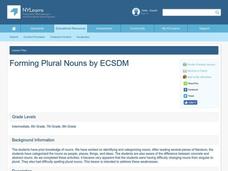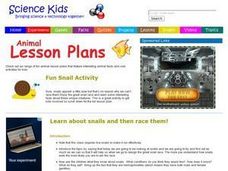Curated OER
Outdoor Observation
Students use observation materials to record what they find outdoors. In this senses lesson plan, students use their five senses to observe things outside. They use a clipboard, pencil, crayons, magnifying glass, and their senses to find...
Curated OER
Take A Meal Worm To Lunch
Seventh graders, using a magnifying glass, observe mealworms in a cup.
Curated OER
The Microscopic World
Students identify magnification by first using a magnifying glass and then with photos taken through a microscope. They complete a handout that leads them through each activity stated. Finally, students use their microscope to view a...
Curated OER
The Amazing Ant
Students explain that ants are an important element of nature's balance. Ants eat many insects and are food to other animals. They watch a video and conduct hands-on activities that give them an excellent overview of the ants role in...
Curated OER
Introducing money (Elementary, Mathematics)
Students study the penny, nickel, dime and quarter, one each day for four days, using a magnifying glass to identify the similarities. Then students discuss differences and value and learn a 'rap' to memorize values.
Curated OER
Forming Plural Nouns
Everyone knows that a noun is a person, place, thing, or idea - but what happens when you have people, places, things, or ideas? Use this SMART board activity to guide your class through plural nouns. Several activities, including making...
Curated OER
Be Kind to Mother Nature!
A clever worksheet on identifying things that harm the environment is here for you. Elementary schoolers read a short paragraph describing the harm that can come to the environment due to human activities. Then, they must circle five...
Curated OER
Forming Plural Nouns
Interactive SMART Board activities provide young grammarians with practice changing singular nouns to plural nouns. Learners then create collages on which they inscribe the singular and plural form of the noun label.
Curated OER
Animals Must Fit In
A instructional activity on tadpoles is here for your young biologists. Learners read a short paragraph on tadpoles, then answer three questions regarding how parts of their bodies help the tadpole to survive in the pond. There is a good...
Concordia College Archives
Introduction and Student Inquiry
Introduce young musicians to the history of and different styles of music with an inquiry-based learning activity that asks them to play detectives to determine the similarities and differences among the sheet music found at a series of...
LABScI
The Separation Lab: Candy Colors
There's no better motivator than candy! An engaging activity has pupils explore methods for separating mixtures. A two-part lab first explores methods of separation based on size and magnetism. The second activity introduces learners to...
PBS
1000 Words
A picture really can speak a thousand words—no matter how old! Scholars become history detectives as they learn how to analyze historical photos and evidence to uncover the past. The fun hands-on activity makes history come alive through...
Curated OER
Habitats of the Pond
Learners explore biology by researching habitats for organisms. In this water environment lesson, students utilize a magnifying glass to examine the different organisms that live on a nearby pond or lake and explore their habitats....
Curated OER
The Museum under the Magnifying Glass
Students research different aspects of a museum through its website. They distinguish responsibilities performed by the people who work in museums and read about collection procedures.
Curated OER
Learn about snails and then race them!
Students examine snails and make observations about where their eyes are located, how they eat, and how they move. In this snails lesson, students discover information about snails by observing them. Students use magnifying glass, a...
Curated OER
What is in Soil?
Fourth graders identify and examine the components that make up soil. Individually, they use a magnifying glass to identify the organic and inorganic material in their soil sample. To end the lesson, they record the differences in the...
Exploratorium
Water Sphere Lens
With a Florence flask or fishbowl, make a double convex lens and use it to examine an image. Because of the refraction, the image will be inverted. A simple explanation is provided here for you to share with your class as they...
Science Friday
Ugh, a Bug!
Young entomologists familiarize themselves with the physical characteristics of insects. Composed of two activities, each activity involves your scientists tapping into their prior knowledge of bugs and making observations of real live...
Curated OER
Stator limbatus Study, Part 1
Second graders experiment identifying beetle emergence and exit holes in seeds, count them, look for beetle eggs with a magnifier and count how many beetle eggs they find. They then graph on a data sheet the findings from their research.
Curated OER
Earth, Sun and Moon
Young scholars explore, experiment and study how the Earth orbits the Sun once a year and how the moon takes approximately 29 days to orbit the Earth. They access an online activity to examine the process of how the Sun is at the center...
Curated OER
Related Lessons Animal
Learners examine the extinction of dinosaurs. In this dinosaur lesson students create their own dinosaur eggs, get into groups and complete a diorama activity.
Curated OER
Magnifying Max: Adding Two
In this adding two worksheet, students create a pattern showing how each group of ants grows by two. Students solve four problems.
Curated OER
Insect Matching
Third graders match insects to the proper order based on the characteristics. They culminate their study of the orders that insects belong in by looking at insects with magnifying glasses.
Curated OER
A Distant View
Students investigate the essential concepts of how lenses work to magnify vision, and then build simple telescopes to demonstrate their understanding. They write a description of how their telescope could be improved and how it works.

























